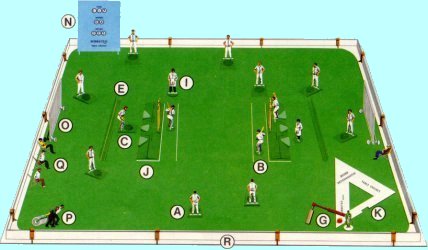
| Peter Upton's |
Subbuteo Tribute Website. |
Table Cricket. |
OO Scale Accessories 1966-83. |
When the OO editions of cricket were introduced in the late 1960s they were fully supported by this compact, but delightful range. The initial size of the range was TC-A to TC-M, which simply consisted of spare parts for the standard game. By 1969 the range reached TC-R, but was not added to after that date. With the notable exception of the fence, most of the the accessories survived alongside the box sets until the Waddingtons purge circa 1982-83.

This lovely illustration comes from the 1969 catalogue and shows the range of Subbuteo accessories.
Boxes and Bags: Cricket Packaging Explained.

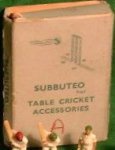

The cricket range was introduced around 1966, and ended up featured in two distinct styles of packaging. The 1960s boxes have an unsatisfactory logo (in my view) showing a ball heading towards a wicket. Many of the accessories were boxed in this period. The larger boxes in this era had light blue centres bordered with white (matching the football range). The smaller items could be supplied in a multipurpose box (as shown above), but the umpires have been sighted in a box that has TC-I printed on it, so I assume that some of the other small items also had their own boxes. A 1960s header-card is illustrated under TC-P, the roller set (introduced in 1967).
For the 1970s re-box only the fielding side, sightscreens, scoreboard and fence remained boxed. The fence was often sold in the green football box (usually a green box with a white lapel). The specialist boxes had a logo featuring a cricketer hitting a ball towards the viewer that matched the football and rugby logos of the same era. The smaller accessories were generally sold in transparent polythene packets sealed with a stapled card label, again matching the other accessory ranges of the period (the cricket labels were light blue unsurprisingly).
TC-A: Fielding Side Set.
including bowler, wicketkeeper and nine fieldsmen
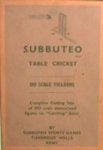
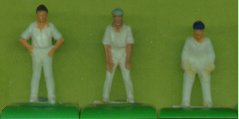
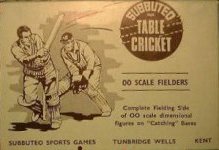

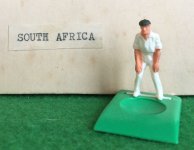
There were two fielding figures, with or without a cap. There was also a crouching wicketkeeper with gloves, and the stand-alone boxes of fielders also put a bowler figure into a fielder base (for caught and bowled dismissals). There were several alternative packs available:-
Some years ago, Pete at Subbuteoworld also found a South African team with darker green caps than Australia. This variation isn't shown in the catalogues (but is illustrated here on the far right). Another website visitor has mentioned owning Pakistan and India in named boxes in the early 1970s. These teams were simply the dark blue and green capped players, but with brown skin.
Of course, these kits come from an era where all cricketers wore white. If Subbuteo Cricket was remade for the 21st Century (unlikely I know) then it could have a proper range of teams featuring the multi-coloured outfits used in one-day internationals.
April 2001: I've now discovered a company that was thinking along the
same lines. Check out the coloured players available for the
Wicketz
board game. Super stuff.
March 2011: See the batsmen section below for Subbuteo's planned painted
cricketers...
December 2020: Named box expert Mark Skellon has supplied a picture of the South Africa box. Whereas the official catalogued teams have name stickers, this one has a typed label. Does this mean that it was a shop request?
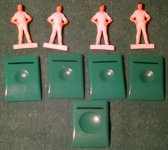
Illustrated above is a rather strange fielding anomaly. Occasionally, bases turn up with a much smaller catching area. I've known teams with just one of these bases in them, but here is a bigger group. This obviously needed a different mould, so perhaps it was the original test one, a trial or a mistake. Just another bit of Subbuteo weirdness..... (and thanks to Mike Stephenson for the photo).
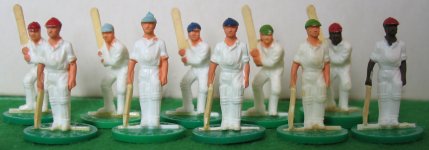
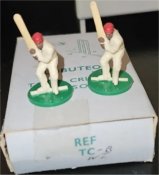
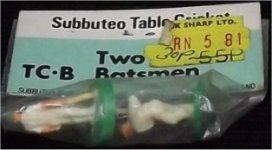
Available in the same colours as the fielding sides. The light blue capped batsman is the hardest to find, because the club/display versions tended to have red capped batsmen and light blue capped fielders. The test batsmen all turn up in Test match Editions, although the West Indies appear less often (possibly because their skin colour would not match the fielders). The West Indies batsmen are the best of the range, and really look the part. Note that the batsmen are sometimes on the large, thick bases usually seen on the 1960s photographers and policemen (from the football range). The action pose West Indian batsman illustrated is on one of those bases.
As I mentioned on the boxed editions page, the standing batsman was actually designed later than the batsman at the crease. Model maker Charles Stadden invoiced for the "action" batsman alongside the fielders in February 1962, but the standing batman was not invoiced until January 1966. The early sets have two "action" batsmen, and I assume that was the case with the early accessory as well. (If you look at the catalogue picture at the top of this page, only the one batman type is illustrated).
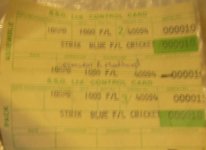
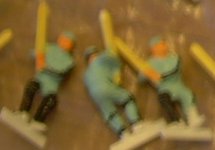
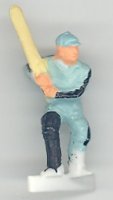
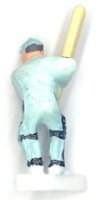
Here's an interesting find. As the SSG control card reads (if you can make it out) these were blue batsmen painted for the floodlit cricket game. In the floodlighting set the batsmen still wore white, but had black pads, whilst the box showed the coloured kits from the Australian World Series. Richard Payne's book "Fifty Years of Flicking Football" states that Subbuteo were planning to issue coloured kits, but the cricket game was withdrawn before these teams reached the shops - and the stock was destroyed. Pleasingly, these batsmen seem to have missed the destruction order. Thanks to Jon Rosten who found these figures.
December 2020: Trevor Spencer, who managed SSG production in the 1980s has told me that the last cricket thing he did was a "NatWest special with pyjamas on", which didn't go into production. The Natwest trophy was originally a 60-over tournament, with the first version being played over the summer of 1981. All cricket items were dropped in 1983.
August 2022: Better pictures of one of the blue batsmen, so you can see
the details. Note that some of the batmen have one pad painted, and some have
both. It is impressive that the hair got painted around the back of the helmet really.
TC-C: Two sets of stumps, bails and wicket rests.
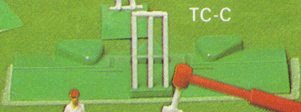
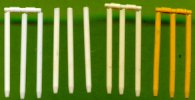
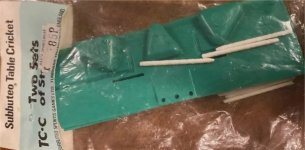
The rather complicated wicket stand is also designed to hold bowling figure TC-M, and to channel balls to the wicket keeper and the slips. For the completists among you, I present Ric Bagnall's guide to stump colours. From left to right we have pure white, off-white, cream and yellow. Those yellow stumps are just fabulous. We should start a campaign to get ebay sellers to quote stump colour in their descriptions :-)
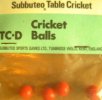
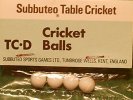
There really is nothing much I can say about this set :-) You can see the size of the cricket ball by looking at the illustration of TC-L the bowling figure. I've been informed that you could also request a bag of white balls from Subbuteo in the early 1980s if you needed to replace those in the floodlighting set (and a set is now illustrated). The white cricket ball also doubled up as the "pea" inside Subbuteo whistles (set V in the football range), so perhaps they already had these kicking around the factory!
TC-E: Two wicket stops.
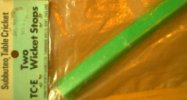
This was simply a very thin right-angled piece of green acetate, designed to stop the ball once it had passed behind the wicket rests. This represented the fact that in real life the wicket keeper would stop most balls that had passed the bat. It therefore cuts down on byes.
TC-F: Three scorebooks
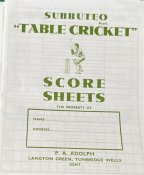
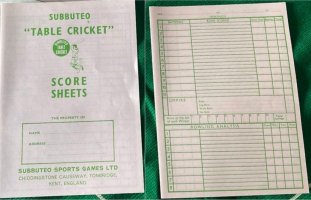
These small sheets carried forward from the early days of Subbuteo cricket. In fact they were in the first edition back in 1949. The only thing that seems to change are the Subbuteo logo and illustration on the front. The original version is shown on cricket accessories - flat era. The two here are from the 1950s-60s (on the left) and 1970s (on the right; front and back). You could buy these sheets for 17p in 1976, but couldn't buy them at all by 1981.
TC-G: One bat.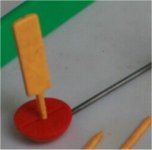
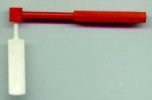
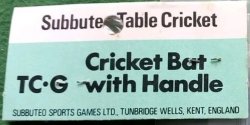
TC-H: Two spare bats.
![]()
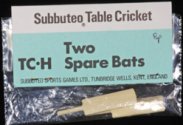
Figuring this is the bit of the bat you are going to break, the white "bat" part of set TC-G was available separately. This cost a stunning 8p in 1976! As with the stumps, the bats can also be off-white or a rather nice cream colour.
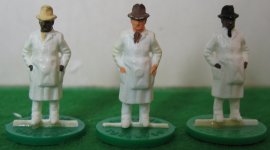
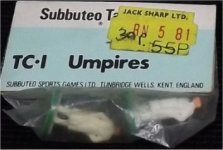
These come on a flat, round, green base, but often come loose, meaning that they can also be placed into a football base. Unfortunately, they are useless as a footballers because they are far too top heavy, but they can be used as a goalie... Football aside, this was another atmospheric cricket accessory. You can also find the occasional West Indian umpire with cream hat or black hat (the cream was the colour usually used to paint the bats). The set came in a box in the 1960s, and a bag in the late 1970s.
TC-J: Green playing cloth.
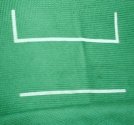
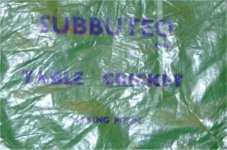
Same size as the football and rugby pitches, which for once seems almost too small. The pitch has a near rectangular boundary with rounded corners, and also has lines marked for the bowling and popping creases. The illustration above shows the crease (in more ways than one) on a 1980s nylon cricket pitch. It is unusual (and probably unlucky) to find a nylon cricket surface. Again, we have Mike Stephenson to thank for finding this one.
TC-K: Rules and Determinator.
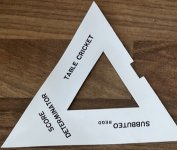
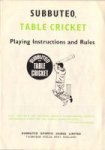
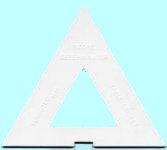
The rules book illustrated here is copyright 1975. The score determinator is used to measure the distance the ball has travelled from the nearest batsman. Its length equals one run. It is also used to show when run outs can be attempted. The score determinator was originally supplied in a very thin "papery" plastic, but soon became a thicker more study item. This later version was also available in green plastic.
TC-L: Single bowler figure.
On base with wire triangle

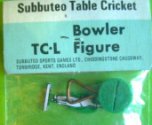
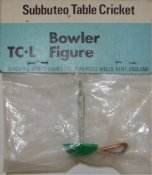
TC-M: OO Scale bowler figure.

The bowler figure shown here was designed to slot into the wicket rest to show which side of the wicket the bowler is running. I have always suspected that Subbuteo designed this to do the actual bowling, but found that the old card player was more effective. As mentioned in the fielding side entry, this figure can be found in a catching base in the full team sets, but never in the box sets, or as an individual piece.
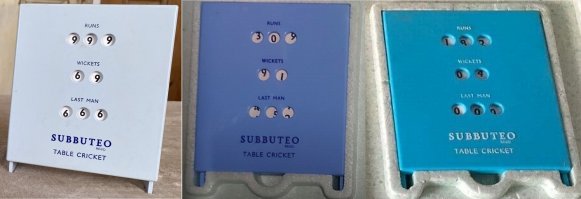
As supplied in the test match edition of the game, this blue scoreboard is the standout cricket item. As you can probably see, it has displays of runs, wickets, and "last man". There are twiddly knobs at the back to move the figures around. Although the scoreboard is always blue, there are actually at least three different shades.
August 2022: - The three tones of blue are now illustrated. The light blue seems the earliest version, and the most common. The mid-blue with white text only appears in the final 1980s Test Match editions.
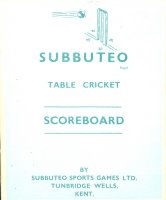
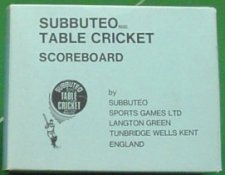
TC-O: Two Sightscreens.
Realistically moulded in polystyrene. These effectively counteract any distractions while batting.
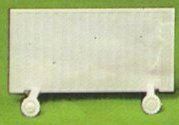
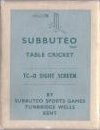
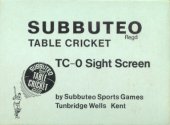
TC-P: Two groundsmen with roller.

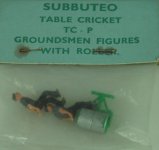
This is Subbuteo cricket's nod towards the football "stand around the pitch" range of OO extras. The roller was produced in both white and green plastic. Just think, if Subbuteo was still alive today, we could have an OO version of the motorized roller they use at test matches. Cool. Oh, and how come Subbuteo never did "the covers"? Recreate rained off matches on your tabletop. The second illustration shows the early (1960s) style of card header, and also shows the green roller rather nicely.
TC-Q: Spectators.
sitting in four gaily-coloured deckchairs.
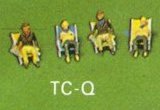
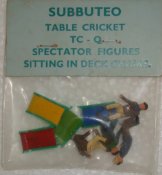
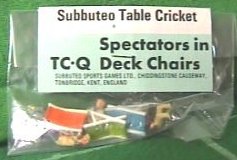
TC-R: Boundary fence.
moulded in white plastic.
1960s Version.
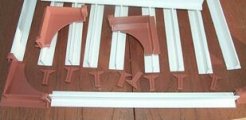
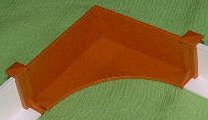
The cricket range pre-dates the green football fence by several years, and the 1960s catalogue drawing shown at the top of this page is a tantalizing glimpse of the original cricket fence. Well, I've finally managed to get pictures of the actual item, and as you can see, the illustration is a very accurate representation. What we have are long white plastic pieces in a T-shape, with small brown posts to lock them together. These look similar to the ones on the later fences, but not identical by any means. The corner pieces are large with a nice curve on the base. These are in brown, rather than the white of the drawing. This looks a more robust fence than the 1970s one, and less likely to be knocked over.
1970s Version.
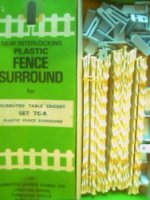
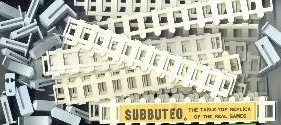
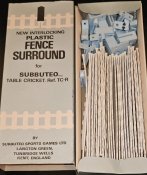
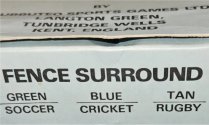
This second version of TC-R is simply a white and pale blue version of the aforementioned football fence (C108). The rugby game had a brown (tan) version, and this helped to unify the Subbuteo brand across the different ranges (and was probably cheaper to make as well). The 1970s football box had space to highlight whether the fence was a cricket, rugby or football version. The cricket fence had left the range before the 1981 catalogue, and was never included in a full cricket edition.
Well that's all the Subbuteo cricket range. But don't worry, there's plenty more Subbuteo to amuse you.
[ Main Page | Previous Page ]